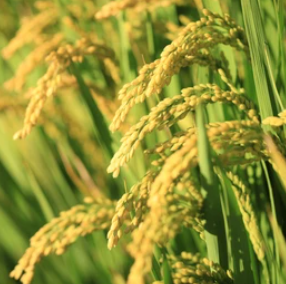Information report for OsPR10a;PBZ1
Gene Details
|

|
Functional Descriptions
- gid1, a gibberellin-insensitive dwarf mutant, shows altered regulation of probenazole-inducible protein (PBZ1) in response to cold stress and pathogen attack.
- These results suggest that the expression of PBZ1 is regulated by GA signalling and stress stimuli, and that gid1 is involved in tolerance to cold stress and resistance to blast fungus.
- When transgenic plants were inoculated with virulent blast fungus (Magnaporthe grisea), they developed many resistant-type lesions on the inoculated leaf accompanying earlier activation of defense-related genes PR-1 and PBZ1 than in control plants.
- Both mRNA and protein analysis showed that PBZ1 was not induced by salicylic acid or an active metabolite, 1,2-benzisothiazole-1,1-dioxide.
- However, upon chitin treatment, the expression of defense-related genes PAL1 and PBZ1 in the cell culture was greater in the mutants compared with wild-type plants.
- Orysa sativa pathogenesis-related protein 10a (OsPR10a) was induced by pathogens, salicylic acid (SA), jasmonic acid (JA), ethephon, abscisic acid (ABA), and NaCl.
- Probenazole (PBZ) induces non-race specific resistance in rice plants against rice blast fungus and PBZ1 was identified as a PBZ-inducible gene from rice.
- The lines with overexpression showed constitutive expression of many defense-related genes, such as PBZ1 and OsSci2, as well as early auxin-response genes, such as OsIAA4 and OsCrl1 genes.
- Expression of defense genes PAL1 and PBZ1 as well as OsRap2.
- Co-treatment of leaf blades with CK and salicylic acid (SA), but not with either one alone, markedly induced pathogenesis-related genes OsPR1b and probenazole-induced protein 1 (PBZ1).
- Under normal growth conditions, there was more PBZ1 protein in gid1 than in the wild type.
- Identification of an OsPR10a promoter region responsive to salicylic acid.
- We demonstrated the inducibility of OsPR10a promoter by SA using transgenic Arabidopsis carrying OsPR10a:GFP as well as by transient expression assays in rice.
- Transgenic rice and Arabidopsis overexpressing OsPR10a significantly increased the length of primary root under phosphate deficiency (-Pi) condition.
- These results showed that OsPR10a might play multiple roles in phosphate recycling in phosphate-starved cells and senescing leaves, and could improve resistance to pathogen infection and/or against chewing insect pests.
- Our findings suggest that gene regulation of OsPR10a could act as a good model system to unravel the mechanisms behind the correlation between Pi starvation and plant-pathogen interactions, and also provides a potential application in crops disease resistance.
- Overexpression of a constitutively active truncated form of OsCDPK1 confers disease resistance by affecting OsPR10a expression in rice.
- OsPR10a and OsCDPK1 showed corresponding expression patterns and were up-regulated in response to the jasmonic acid, salicylic acid and Xoo treatments, and OsPR1 and OsPR4 were significantly up-regulated in OEtr-1.
- The rice pathogenesis-related protein OsPR10a was scarcely expressed in OsCDPK1-silenced (Ri-1) rice, which was highly sensitive to pathogen infection.
Functional Keywords
- gibberellin , blast , salicylic-acid , defense , resistant , cold-stress , leaf , jasmonic , dwarf , ga , growth , jasmonic-acid , auxin , iaa , sa , root , resistance , insect , disease , disease-resistance , primary-root , Pi , phosphate , pi , pathogen , xoo
Literature and News
- Light-dependent induction of OsPR10 in rice (Oryza sativa L.) seedlings by the global stress signaling molecule jasmonic acid and protein phosphatase 2A inhibitors . DOI: 10.1016/s0168-9452(01)00433-2
- Involvement of OsNPR1/NH1 in rice basal resistance to blast fungus Magnaporthe oryzae . DOI: 10.1007/s10658-011-9801-7
- Identification of an OsPR10a promoter region responsive to salicylic acid . DOI: 10.1007/s00425-007-0687-8 ; PMID: 18193274
- Characterization of PBZ1, a probenazole-inducible gene, in suspension-cultured rice cells . DOI: 10.1271/bbb.65.205 ; PMID: 11272832
- Constitutive expression of pathogen-inducible OsWRKY31 enhances disease resistance and affects root growth and auxin response in transgenic rice plants . DOI: 10.1038/cr.2007.104 ; PMID: 18071364
- gid1, a gibberellin-insensitive dwarf mutant, shows altered regulation of probenazole-inducible protein (PBZ1) in response to cold stress and pathogen attack . DOI: 10.1111/j.1365-3040.2005.01441.x ; PMID: 17080612
- Cytokinins act synergistically with salicylic acid to activate defense gene expression in rice . DOI: 10.1094/MPMI-06-12-0152-R ; PMID: 23234404
- Inducible overexpression of a rice allene oxide synthase gene increases the endogenous jasmonic acid level, PR gene expression, and host resistance to fungal infection . DOI: 10.1094/MPMI-19-1127 ; PMID: 17022177
- Characterization of transgenic rice plants over-expressing the stress-inducible beta-glucanase gene Gns1 . DOI: 10.1023/a:1020714426540 ; PMID: 12602898
- A novel rice PR10 protein, RSOsPR10, specifically induced in roots by biotic and abiotic stresses, possibly via the jasmonic acid signaling pathway . DOI: 10.1093/pcp/pch063 ; PMID: 15169937
- Gene editing a constitutively active OsRac1 by homologous recombination-based gene targeting induces immune responses in rice . DOI: 10.1093/pcp/pct147 ; PMID: 24158358
- OsRap2.6 transcription factor contributes to rice innate immunity through its interaction with Receptor for Activated Kinase-C 1 (RACK1) . DOI: 10.1186/1939-8433-5-35 ; PMID: 24280008
- Multiple Patterns of Regulation and Overexpression of a Ribonuclease-Like Pathogenesis-Related Protein Gene, OsPR10a, Conferring Disease Resistance in Rice and Arabidopsis . DOI: 10.1371/journal.pone.0156414 ; PMID: 27258121
- Overexpression of a constitutively active truncated form of OsCDPK1 confers disease resistance by affecting OsPR10a expression in rice . DOI: 10.1038/s41598-017-18829-2 ; PMID: 29321675
- Magnaporthe oryzae systemic defense trigger 1 (MoSDT1)-mediated metabolites regulate defense response in Rice . DOI: 10.1186/s12870-020-02821-6 ; PMID: 33430779
- Application of jasmonic acid at the stage of visible brown necrotic spots in Magnaporthe oryzae infection as a novel and environment-friendly control strategy for rice blast disease . DOI: 10.1007/s00709-020-01591-0 ; PMID: 33417037
Gene Resources
- UniProt: B9GDP9
- EMBL: AP008218, CM000149
- AlphaFoldDB: B9GDP9
- EnsemblPlants: Os12t0555500-01
- Gramene: Os12t0555500-01
- KEGG: dosa:Os12g0555500
- Orthologous matrix: TVYTMKL
- InterPro: IPR000916, IPR023393, IPR024949
- PANTHER: PTHR31213, PTHR31213:SF168
- SUPFAM: SSF55961
- Gene3D: 3.30.530.20
- OrthoDB: B9GDP9
- SWISS-MODEL: B9GDP9
- Conserved Domain Database: cd07816
Sequences
cDNA Sequence
- >LOC_Os12g36880.1
GGAGCTGAGTTCCCAACTGCAACATTTATTCTGGATGATGTCTTCTTCTCCTCTTGCCACCCTATAAATAGCCCATGCTACTGCTCACCTTTGAAGCACAAGCACAAGCACAAGCAGCTCTAGCTAGCTACAGGCATCAGTGGTCAGTAGAGTGATCAGTTGCAACTAGCTAGCTAGTTAGATTATATCTTCAGTGATGGCTCCGGCCTGCGTCTCCGACGAGCACGCCGTCGCGGTGTCGGCGGAGCGGCTGTGGAAGGCGTTCATGGACGCGTCCACTTTGCCCAAGGCCTGCGCCGGCTTGGTCGACGACATTGCGGTCGAGGGGAACGGTGGTCCGGGCACCATCTACACCATGAAGCTTAACCCTGCCGCGGGTGTGGGAAGCACATACAAGACCCGGGTGGCGGTGTGCGACGCCGCAAGTCATGTCCTAAAGTCGGATGTGCTCGAGGCAGAAAGCAAGGTGGGGAAGCTCAAGTCACACTCGACGGAGACGAAGCTTGAGGCCACCGGCGATGGCTCCTGTGTGGCCAAGCTCAAGGTGGAGTACGAGCTCGAGGACGGCAGCTCACTGTCGCCGGAGAAGGAGAAGGACATCGTGGATGGCTACTATGGCATGCTCAAGATGATCGAGGACTACCTCGTCGCTCACCCTGCCGAATACGCCTAAGATGAAGAGGAATACTGCCTCTATCCAGTATATCCCACCTAGAGTGAGTGATAATTAAATAATGAGAGCCGCAGAAATGTCCAAATTCTCGTGGCGTTTGAGTCCGTGAGAGTAATTTCGTGCTTTAAGTTTGTGGTTGTGTTTATGTGCCTTTCTATGGTCGTATTCAGTGTTAAAGTTATCATTTTGCTTCATCAATGGGTGAATAAAGAGAGGCAAGTCTGAATGTGTTCTGCTATGGTTTGGAGGTTAATATGGAAGATTGAAAATCATTGTGAATGCTGCCGATCAGAAATACTACATGCTATTAAGA
CDS Sequence
- >LOC_Os12g36880.1
ATGGCTCCGGCCTGCGTCTCCGACGAGCACGCCGTCGCGGTGTCGGCGGAGCGGCTGTGGAAGGCGTTCATGGACGCGTCCACTTTGCCCAAGGCCTGCGCCGGCTTGGTCGACGACATTGCGGTCGAGGGGAACGGTGGTCCGGGCACCATCTACACCATGAAGCTTAACCCTGCCGCGGGTGTGGGAAGCACATACAAGACCCGGGTGGCGGTGTGCGACGCCGCAAGTCATGTCCTAAAGTCGGATGTGCTCGAGGCAGAAAGCAAGGTGGGGAAGCTCAAGTCACACTCGACGGAGACGAAGCTTGAGGCCACCGGCGATGGCTCCTGTGTGGCCAAGCTCAAGGTGGAGTACGAGCTCGAGGACGGCAGCTCACTGTCGCCGGAGAAGGAGAAGGACATCGTGGATGGCTACTATGGCATGCTCAAGATGATCGAGGACTACCTCGTCGCTCACCCTGCCGAATACGCCTAA
Protein Sequence
- >LOC_Os12g36880.1
MAPACVSDEHAVAVSAERLWKAFMDASTLPKACAGLVDDIAVEGNGGPGTIYTMKLNPAAGVGSTYKTRVAVCDAASHVLKSDVLEAESKVGKLKSHSTETKLEATGDGSCVAKLKVEYELEDGSSLSPEKEKDIVDGYYGMLKMIEDYLVAHPAEYA*